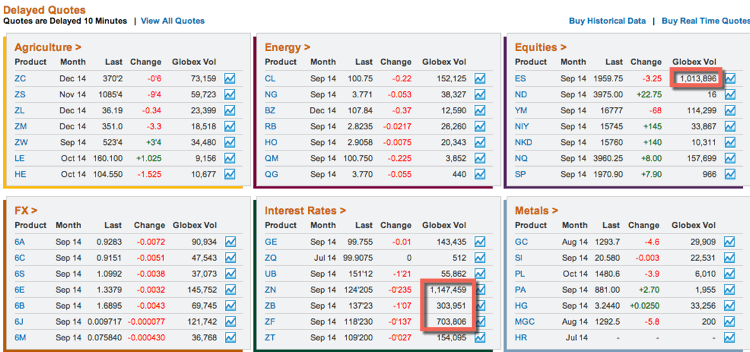About thirteen years ago, as I was approaching retirement from the U.S. Air Force, I knew I would have more time to devote to trading. I have a friend in Australia with two PhDs who built his own trading software in the 90s. His software exclusively used the ES futures for intraday trading. I spent a lot of time learning how to use his software and studying technical analysis and directional trading techniques. It's very different than the income style of option trading that I've gravitate to now.
Getting Educated
Before I started trading futures, I wanted to understand what they were and how they traded. The best place to start with are where the contract specifications are. In the case of the ES futures, that's at the CME's web site:
http://www.cmegroup.com/trading/equity-index/us-index/e-mini-sandp500_contract_specifications.html
On this page, you can see the ticker symbol, contract size, tick size, trading hours and more information.
Another good reference is Joe Ross's “unit move table.” Joe's unit move table is a great overview for all sorts of futures contracts.
Trading Futures Options
After you've done a little homework about the futures you want to trade, start watching it on your broker platform. Look at the price charts and see how the futures move. Some futures like currencies for example, can have periods of very low volatility but one announcement from a central bank can explode the futures in one direction. It's almost like an earnings event. That's one reason I tend to stick to index futures options. There's less of that type of large movement.
When you are examining your futures options, look at the open interest and daily trading volume of specific option contracts. Not all futures are created equally with volume! A quick guide to what is trading with higher volume is the CME's home page. This is a great page for quickly seeing how the markets are trading 24/7:

I've highlighted a few of the contracts that have traded over 300,000 contracts today.
Are Futures Options Trades Different Than Stock or Equity Index Options?
Not really. You can use the same option strategies using futures options that you can with stock options or equity index options:
- Iron Condors
- Butterflies
- Calendars
- Diagonals
- Verticals
- And more…
You may have less option volume and open interest in the futures options than with similar index options, but I find I still get good fills.
Why Should I Trade Futures Options When I Can Trade The Indexes Instead?
Good question. I have several reasons:
- Margin: Futures and futures options use SPAN margin, which is a risked based margin. You don't need a $100,000+ portfolio margin account to get risk based margin.
- Trading Hours: Futures and futures options trade nearly 24-hours during the week. If you need to make an adjustment to your position outside of U.S. market hours, you can. I had a fill outside of normal U.S. trading hours just yesterday!
- Underlying: You can buy or sell the underlying futures contract similar to buying or selling a stock. You can setup a covered call with futures options for example.
In some countries, margin is not as lenient for iron condors as it is in the United States. The only way to get margin relief typically is to trade futures options.
Summary
Don't be afraid to try trading futures options if you're already trading stock or equity index options. They are nearly the same but have some distinct advantages such as being able to buy or sell the underlying futures contract, SPAN margin (risk based) and they trade nearly 24-hours per day during the week.
Join us in the forums to discuss your option trades, including any questions you have about futures options!



I didn’t know that futures trading was so beneficial. The fact that they can be traded at basically any time and use SPAN margin does make them pretty appealing. I might have to check out some broker forums and see if I can start trading futures! Thanks for the article.